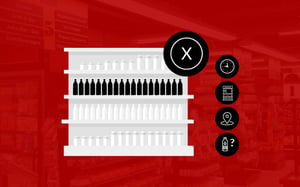Shelving mistakes happen. There is no harm in admitting that. It’s also not a problem if you go about fixing them. What is a problem, though, is when you know you’ve made a mistake and then do nothing to fix it.
Of course, the other side of the coin is that you don’t know you’ve made a mistake. Either way, it needs to be asked: are you guilty of making any of the below mistakes?

Mistake 1: There is no consistency
It doesn’t matter which shelving your choose for your store. You could choose wooden shelving. You could choose wire shelving. You could choose glass shelving. Even plastic shelving if you want to.
What does matter though is that you’re consistent in what you use. After all, there isn't much worse than seeing a wooden shelf standing next to a wire shelf. And there's a plastic shelf besides them. Also, they're all different sizes and shapes. It's aesthetic unappealing.
That's not to say that you can't use different types of shelving in your store. You most certainly can. But it's important to maintain a level of consistency. Place your wooden shelving next to each other, for example and your wire shelving together elsewhere in your store.

Mistake 2: Your shelving doesn’t match your retail brand
Your customers have a certain level of expectation when they enter your stores.
If you're a high-end retailer who stocks expensive clothing, for example, they'll expect to see shelving that complements your products. That means it'll be sophisticated and elegant. A perfect example is the boutique we mentioned in our article on the best and worst wire shelving we’ve seen. Their shelving matches the retail brand perfectly.
The mistake of it not matching your brand can lead to shopper frustration and confusion. You promise them one thing and they get something else.
Mind you, don’t think this is just for high-end retailers. No matter what type of retailer you are or what image you’re trying to portray, your shelving must match your brand.
Mind you, this isn’t only for high-end retailers. No matter what type of retailer you are, this applies to you.

Mistake 3: Your shelves are dirty
One of the worst things that you can have as a retailer is an unclean store. You can have the widest range of products and the best customer service. You can even have the best prices. But it will count for nothing if your stores (and by association your shelves) are dirty.
Just to note, it’s not only food retailers who need to monitor the cleanliness of their shelves. This goes for every single retailer.
Can you image what it would be like for your customers to shop your store when your shelves are dirty or your products are covered in dust? Would they even want to?
Rather be safe and clean your shelves often. The last thing you want is a customer telling you (and everyone they know) that your shelves are dirty.

Mistake 4: When your shelves aren’t installed properly
Besides the mistake of having dirty shelves, another hazard is when your shelving is not installed properly. In fact, it could even be argued that it’s worse than dirty shelves. That’s because it’s harder to hide.
You'll know it when you see it: your retail fixtures are falling over. They might even be broken and in need of immediate repair.
That said, this isn’t only about repairing already run-down shelves. It’s also about having the foresight so that you don’t get to the point where your shelves are looking shoddy. As we’ve mentioned in the past, the goal of shelving is to present your products in a way that pleases your customers.
That’s not going to happen if your shelving isn’t level and your products are falling off. Or if a sharp angle is sticking out into the aisle waiting for your customers to bump into it and injure themselves.

Mistake 5: When you either don’t accessorise or accessorise too much
A cluttered shelf is a problem if you’re a retailer. You only need to look at any overstocked shelf or messy one to know that. What makes it worse is if you add in shelf talkers and other promotional banners in an attempt to grab the attention of your customers. This level of accessorising your shelves is not going to get you the result you want.
You need to cut down on the amount of accessorising that you do. Don’t cut it out completely though - your customers do want to know if there are any specials or deals. But rather look for a balance between too much accessorising and too little. Your customers will thank you for it.
And know this: when using correctly, shelf talkers play a significant role in the success of your category management strategy.

Mistake 6: When your price tags are a mess
Long queues and little to no customer service are just two of your shoppers' pet hates. It’s easy to understand why. It makes for a frustrating shopper experience.
Here’s another frustration: messy or missing price tags. And it’s not a trivial issue.
You only need to consider a customer who is on a limited budget and doing their weekly grocery shop. Or even one who likes to compare products to find the best price. They get to the shelf and it’s neatly presented. But there’s no price label for the product they want to buy.
When stocking your shelves, you must ensure that the products are not only positioned in the right place, but that there are price tags to match them. And remember, this is about keeping your shoppers happy and putting them first. Because when you do, they’ll continue to come back.

Mistake 7: Your products are positioned out of reach
It’s all good and well having price tags that match your products on the shelf. If you have that sorted, good. However, the problem comes in when you customer can’t reach these products in the first place.
It’s a mistake to think that you should buy shelving and then stack it as high as you can. Yes, part of the reason for shelving is to maximise your store space. But it doesn’t help if you’ve placed your products out of the reach of your customers. And you can’t argue that you’ll simply help them - what if a staff member is not around? Do you expect your customers to hang around?
By the time your staff does get around to helping, they may already be halfway out the door. Rather focus on shelving that allows your customers to shop conveniently and at their own pace.

Mistake 8: Your product assortment is too narrow (limited assortment)
The product assortment you choose for your stores is vital to your success as a retailer. By keeping your product variety narrow and limiting your product range, you stand a good chance of not meeting the needs of your shoppers. As a result, they’ll shop somewhere else.
Of course, it does depend on what type or retailer you are. If you’re a specialist store, you’ll no doubt have a deep assortment of a single product. If you don’t, you need to correct it quickly.
It’s easy enough to correct. Offering your customers the right product at the right time and place comes down to localising your assortment planning. Before you go ahead and develop your assortment plan, it’s also worth looking at the various elements that you need to consider.
Once you have the right assortment on your shelves, you’ll stand a better chance at pleasing your customers and enticing them to return again.

Mistake 9: You neglect the layout of your actual shelves
While this piece is primarily focused on shelving mistakes so that you stop making them, it’s necessary to also mention the layout of your actual shelves.
Why? Simply put, you can have the best shelves and everything in place but it won’t matter if you don’t pay attention to what goes onto your shelves.
This is where shelf planning comes in. Also known as space planning, it’ll not only help you determine how much of your merchandise needs to be placed on your shelf but also where it needs to go.
As a result, you can expect a more visually appealing store (let alone shelf) and increased sales. Plus, you’re improving customer satisfaction.


